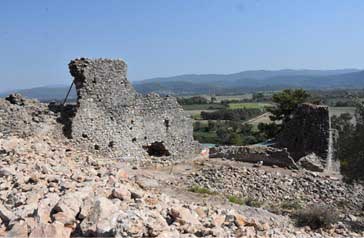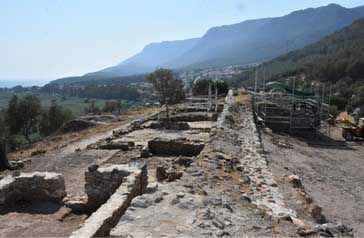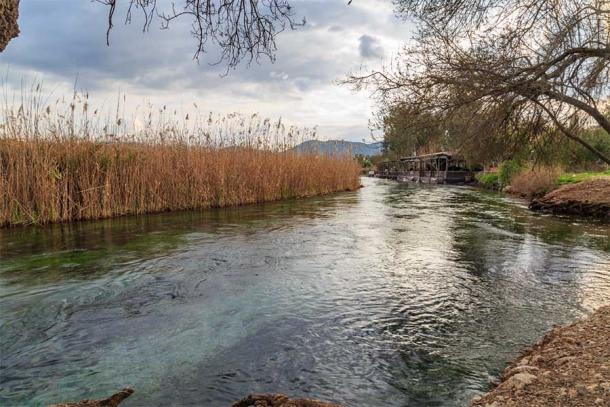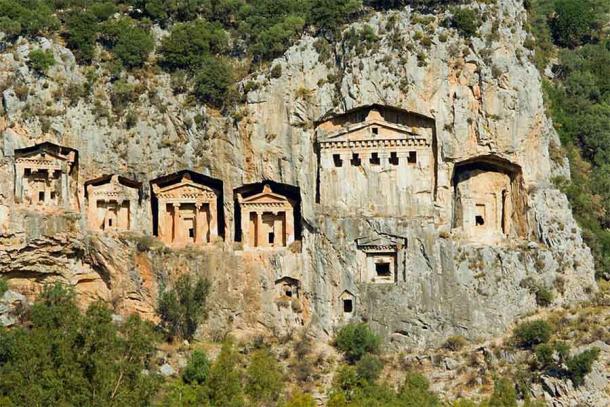
Turkish Archaeologists Find Byzantine Castle at Akyaka, Western Turkey
A team of Turkish archaeologists have been busy since 2020 performing excavations at one of western Turkey’s richest historical and cultural sites. Within the borders of the coastal village of Akyaka, located on the Gulf of Gökova in the southwestern Turkish province of Muğla, they have been searching through ruins associated with the ancient city of Idyma. This important settlement in Western Anatolia (modern-day western Turkey) was a Greek city-state founded by emigrants from ancient Greece, who created multiple settlements in the area. Now the clear outlines of a Byzantine castle found at the Akyaka site have been publicized in photos and the implications are significant.
- Striking Grave Goods Begin to Shed Light on Hellenistic Life in Turkey
- First Greek Snake Altar To Underground Gods Found in Southern Turkey

Part of the Byzantine castle found at the hillside Akyaka site in western Turkey. (Anadolu Agency)
Idyma’s Byzantine Castle Sheds New Light On Carian Culture
It is believed Idyma may have been founded as long ago as 700 BC, and the archaeologists are trying to learn more about various cultures who occupied the city throughout its existence.
So far, their explorations have uncovered a variety of fascinating ruins that appear to have connections to different time periods.
"We are currently excavating places where there are traces of the Hellenistic period, possibly related to the port,” project leader and Muğla University archaeologist Abdulkadir Baran told the Turkish news service Anadolu Agency.
He explained that the Hellenistic period in the area began with the Carian culture, which was responsible for the founding of Idyma in the first millennium BC. Not that much is known about the Carians, although the Greek historian Herodotus claimed they were originally Minoan.
"As our work progresses, our knowledge of the Carian culture, one of the ancient cultures of this region, will be fully completed,” Baran predicted.

Another view of the Byzantine castle walls found at the Akyaka site, which was once known as Idyma, an important Greek city state that was first founded by the mysterious Carian culture. (Anadolu Agency)
While the focus of the project is on the first millennium BC Carians, some of the most significant excavation work has been conducted on a structure that was built in a later era.
“One of the most important areas we excavated and revived in the city is the medieval castle," Baran said.
Known as Akyaka-Inişdibi Castle (because it was built next to the ancient Inişdibi trade route), this crumbling medieval era fortress sits perched on a low hill overlooking the flood plain of the Azmak Creek, which empties into the Aegean Sea via the Gulf of Gökova. The Byzantine castle was constructed when Western Anatolia was a part of the Byzantine or Eastern Roman Empire, a period of time that spans the fourth through the 12th centuries AD.
Some preliminary excavations were undertaken at the castle site in recent years. However, the newest dig, which has been going on steadily for the past 10 months, has gradually uncovered the castle walls, revealing more interesting details about the form and function of this imposing medieval structure.

The beautiful Azmak Creek in Akyaka, Muğla, Turkey, which runs just below the hillside Byzantine castle dig site. (muratani / Adobe Stock)
A Byzantine Castle in Western Anatolia
The medieval castle’s Byzantine-era builders clearly chose this hillside location based on strategic considerations. The hilltop spot is ideally suited for defense, as it offers a panoramic view of the surrounding landscape while remaining difficult to access for invaders arriving from sea on the Azmak Creek. It is believed the site of the castle was once the city of Idyma’s acropolis, making it a central area that needed defending.
Some of the castle walls appear to have been constructed as early as the fourth century AD. However, it may have been expanded in size and reinforced several centuries later, when the Byzantine Empire that built it had to be more concerned about defending Western Anatolia from Turkish invaders, who were determined to seize more lands in the region.
Eventually, Western Anatolia did fall to the Turks, specifically the Seljuk Turks who came from the territory of what is now Iran. The Seljuks established control over Anatolia as a whole in the 11th century, and held that control until the 13th century, when conflicts with the powerful Mongols effectively ended their reign.
The Mongols never gained control over Western Anatolia, however. Once the Seljuks had withdrawn, in the latter 1200s the region around Akyaka fell under the rule of the Principality of Menteşe. This fledgling state was formed by a different branch of Turks known as the Oghuz people.
- Quarrying and Blasting May Destroy 2100-Year-Old Castle Site and Statue of Mother Goddess in Turkey
- Ancient Mall Found in Famous Theater City of Aspendos Shows Commerce and Entertainment Went Hand-in-Hand

A Lycian rock tomb in Akyaka, not far from the Byzantine castle dig site. (Danita Delimont / Adobe Stock)
But the Principality of Menteşe is mostly a footnote in Anatolian history. In 1420 the mighty Ottoman Empireconquered the lands of Western Anatolia, and they remained under some level of Ottoman control until the 20 thcentury. This conglomeration of Turkish tribes completed the region’s transition from Greek and Christian to Turkish and Muslim, and at some point during the Ottoman reign the ancient Greek city of Idyma ceased to exist.
Such was not the case for Akyaka-Inişdibi Castle. The archaeologists excavating its walls found evidence showing the fortress was preserved for many centuries and had been used by both the Seljuks and the Ottomans at various times. This would have undoubtedly dismayed the Byzantine Greeks, who built it to keep the Turkish invaders at bay.

The Lycian rock cut tombs at Dalyan Kaunos, which is located 32 miles (60 kilometers) southeast of Akyaka. Both ancient cities were built by the same cultures, and both were active during the Byzantine period. (OscarKosy / CC BY-SA 3.0)
Exploring an Ancient City at the Crossroads of History
The Byzantine Empire was both Greek and Christian. Its founders were the descendants of the Greeks who’d arrived in Anatolia (like the Carians, for example) and constructed Greek city-states there several centuries earlier.
While representing the Roman Empire in the east, the Byzantine cultural outlook was entirely Greek. In fact, during the Byzantine era Western Anatolia was the nexus of Hellenistic culture, as Greek lands farther east were forced to deal with frequent invasions from the so-called “barbarians.”
When the Byzantine Empire was replaced by Turkish rulers, it represented a profound shift in culture in Anatolia (modern-day Turkey), from Greek and Christian to Turkish and Muslim. Idyma was one city that experienced it all, leaving behind a complex set of ruins and artifacts that archaeologists will likely be digging up and trying to interpret for decades to come.
While the discovery of the Byzantine castle walls is getting most of the attention at the moment, the Turkish archaeologists have also been busy in other sections of the fertile Idyma site. They’ve uncovered several rock tombs that date to earlier times than the castle, and they’ve also been excavating in areas where the remains of ancient churches and Roman-style mosaic floors had been unearthed in the past.
The ancient city of Idyma has now been absorbed into and replaced by the port village of Akyaka and can no longer be found on modern maps. But archaeologists are currently quite busy bringing it back to life, one fascinating discovery at a time.
Top image: The outlines of the Byzantine castle at the hillside Akyaka dig site in Western Turkey. Source: Durmuş Genç / Anadolu Agency
By Nathan Falde















